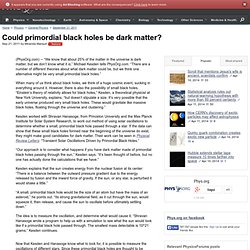

Blow for 'dark matter' theory as scientists find faint, undetected star. Tiny, faint star has mass one-fifth of our SunUndetected stars could make up bulk of star clustersBlow for theory that 'dark matter' accounts for much of universe's mass By Rob Waugh Updated: 18:56 GMT, 22 December 2011 'Dark matter' is a theoretical - and controversial - substance which is undetectable by telescopes on earth, but thought by some scientists to account for up to three quarters of the mass of the whole universe.

That theory received another blow today, as scientists detected a very low mass, faint star in a star cluster for the first time. The result means that the overall mass of such 'globular clusters' could well be explained without having to resort to dark matter. The M22 cluster, where a Swiss astronomer found a faint, previously undetected star. What Higgs result means for dark matter conspiracy. RECENT hints of a featherweight Higgs boson don't just take us nearer to a complete standard model of physics.

The results affect a possible link between the Higgs and dark matter, the invisible stuff making up 80 per cent of the universe's matter. The Higgs is the last remaining hole in the standard model, the leading theory for how particles and forces interact. On 13 December, physicists at CERN near Geneva, Switzerland, presented data from the Large Hadron Collider suggesting Higgs bosons with a mass of 125 gigaelectronvolts (GeV) were made. The Higgs is detected by looking for suspicious excesses of particles that it might decay into. Before the recent finding, some theorists had speculated that the Higgs hadn't shown up yet because it decayed into two dark matter particles, or WIMPs (weakly interacting massive particles), which would be invisible to the LHC's detectors. NASA satellite could reveal if primordial black holes are dark matter. (PhysOrg.com) -- The primary objective of NASA’s Kepler satellite, which was launched in March 2009 to orbit the Sun, is to search for Earth-like planets in a portion of the Milky Way galaxy.

Latest Fermi studies find no trace of dark matter. Independent analyses of data from the Fermi Gamma-ray Space Telescope have found no trace of low-mass dark matter – the mysterious substance thought to make up much of the universe.

The results appear to go against recent direct evidence for low-mass dark matter, although some physicists believe there is no conflict. Dark matter is an invisible substance thought to make up nearly a quarter of the mass/energy of the universe. While its gravitational pull is needed to explain the properties of massive structures such as galaxies, it does not interact strongly with light and has therefore yet to be observed directly. New Study Throws Dark Matter Finding Into Question. A new study of dark matter, the mysterious hidden stuff thought to pervade the universe, casts doubt on a previous finding that offered hope that dark matter had finally been seen.

In 2008, a European-Russian satellite called Payload for Antimatter Matter Exploration and Light nuclei Astrophysics (PAMELA) discovered a strange overabundance of particles called positrons, which are the antimatter counterpart to electrons. Matter and antimatter, which have the same mass but opposite charges, destroy one another when they meet. According to theory, when a particle of dark matter collides with its antiparticle, they annihilate, unleashing a burst of energy and exotic particles.
Search for Elusive Dark Matter May Get Boost From New Galaxies. Astronomers have found two small galaxies that appear to circle our Milky Way's galactic neighbor Andromeda, and could shed new light on the mystery of dark matter in the universe, scientists say.

The newfound dwarf galaxies, called Andromeda 28 and 29, are two of the most distant satellites galaxies from Andromeda ever detected. They are located about 600,000 light-years away from Andromeda, and approximately 1.1 million light-years from Earth, researchers said. The Andromeda galaxy is about 2.5 million light-years away and is the nearest spiral galaxy to the Milky Way. Like our galaxy, Andromeda is surrounded by numerous dwarf satellite galaxies. One step closer to dark matter in universe. Dark Matter Mystery Deepens. Like all galaxies, our Milky Way is home to a strange substance called dark matter.

Dark matter is invisible, betraying its presence only through its gravitational pull. Without dark matter holding them together, our galaxy’s speedy stars would fly off in all directions. Dark Matter: Now More Mysterious Than Ever. Astronomers have one more reason to scratch their heads over the unseen material known as dark matter.

Observations of two dwarf galaxies, Fornax and Sculptor, show the dark matter within them is spread out smoothly rather than heaped into a central bulge, contradicting cosmological models. Hubble survey carries out a dark matter census. Cluster MACS J1206.2-0847 (or MACS 1206 for short) is one of the first targets in a Hubble survey that will allow astronomers to construct the highly detailed dark matter maps of more galaxy clusters than ever before.

These maps are being used to test previous but surprising results that suggest that dark matter is more densely packed inside clusters than some models predict. This might mean that galaxy cluster assembly began earlier than commonly thought. Could primordial black holes be dark matter? (PhysOrg.com) -- “We know that about 25% of the matter in the universe is dark matter, but we don’t know what it is,” Michael Kesden tells PhysOrg.com.

“There are a number of different theories about what dark matter could be, but we think one alternative might be very small primordial black holes.” When many of us think about black holes, we think of a huge cosmic event, sucking in everything around it. However, there is also the possibility of small black holes. “Einstein’s theory of relativity allows for black holes,” Kesden, a theoretical physicist at New York University, explains, “but doesn’t stipulate a size. It’s very possible that the early universe produced very small black holes. Kesden worked with Shravan Hanasoge, from Princeton University and the Max Planck Institute for Solar System Research, to work out method of using solar oscillations to determine whether a small, primordial black hole passed through a star.
How Dark Matter Messes with Our Galaxy. This video shows the spiral shape of our galaxy and two of its small satellite galaxies, the Large and Small Magellanic Clouds (to the left). The satellites orbit the main galaxy and, in the process, trigger slow-motion waves in it. On a human time scale, those waves look like a static warp in the galactic outskirts. The strange thing is that the satellites are too lightweight to have such a dramatic effect. Astronomers recently demonstrated that their gravity is greatly amplified by dark matter (which this video does not show -- it is, after all, dark). Black hole, star collisions may illuminate universe's dark side.
Dwarf galaxies suggest dark matter theory may be wrong. 16 September 2011Last updated at 18:47 By Leila Battison Science reporter, Bradford Dwarf galaxies around the Milky Way are less dense than they should be if they held cold dark matter Scientists' predictions about the mysterious dark matter purported to make up most of the mass of the Universe may have to be revised. Research on dwarf galaxies suggests they cannot form in the way they do if dark matter exists in the form that the most common model requires it to.
That may mean that the Large Hadron Collider will not be able to spot it. Leading cosmologist Carlos Frenk spoke of the "disturbing" developments at the British Science Festival in Bradford. Milky Way Arm Wrestles With Dark Matter. Want to stay on top of all the space news? Follow @universetoday on Twitter. "Dark-Matter" Sagittarius Galaxy Smashed into the Milky Way Twice - Creating Outer Spiral Arms. A dwarf galaxy named Sagittarius loaded with dark matter has careened twice through our much larger home galaxy in the past two billion years, according to telescope data and detailed simulations, and is poised to strike the southern face of the Milky Way disk in another 10 million years or so. Many astronomers believe that the large galaxies seen today were formed from smaller "dwarf" galaxies, which formed first after the Big Bang.
Many of these dwarfs either clumped together to form larger galaxies or were gradually swallowed up by larger galaxies that continued to grow by "cannibalizing" smaller ones.